| Author |
Topic: Stringmaster project |
Brad Davis
From:
Texas, USA
|
 Posted 21 Jul 2017 12:50 pm
Posted 21 Jul 2017 12:50 pm |
|
Now I'm all set on early tuner pans, of the better variety, thanks Russell! I think I cleaned out his long scale inventory, lol.
Still seeking more long scale bridge covers.
I also now have tweed for the case, and I'm going to start to work on the electronics once the new capacitor is delivered and hopefully get it playing soon. |
|
|
|
Bill Sinclair
From:
Waynesboro, PA, USA
|
 Posted 21 Jul 2017 1:39 pm
Posted 21 Jul 2017 1:39 pm |
|
| I'll bet you can sell the raggedy tweed to someone who wants to do a "relic" Champ or Deluxe amp build. Probably not for much but I'll bet there would be some interest. |
|
|
|
Brad Davis
From:
Texas, USA
|
 Posted 21 Jul 2017 2:04 pm
Posted 21 Jul 2017 2:04 pm |
|
| That hadn't occurred to me Bill, it was probably going to get tossed. I'd probably just give it away, assuming it doesn't end up in pieces, it's pretty awful, lol. |
|
|
|
Brad Davis
From:
Texas, USA
|
 Posted 22 Jul 2017 11:09 pm
Posted 22 Jul 2017 11:09 pm |
|
I've installed my 4 best lollipop tuner pans. They shined up nice with Flitz. All 4 tuner wells were marked in blue pencil with "RFSd 12-54". I think I also swapped one nut. All of these tuners are of the better variety with the bracket instead of the individually spot welded tuners.
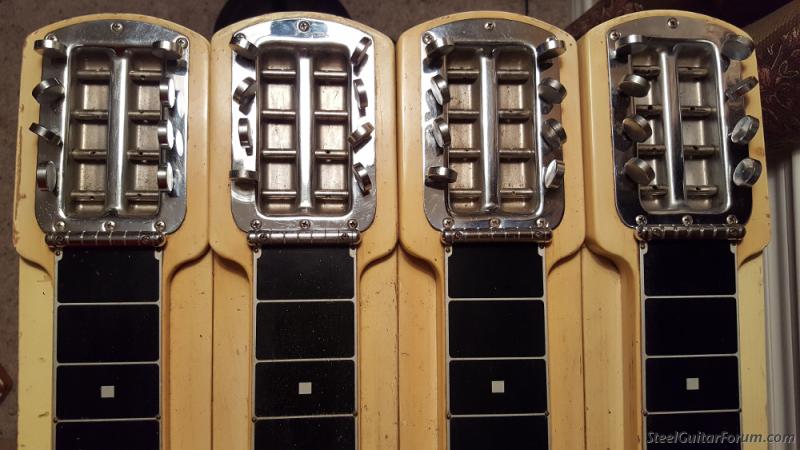
I'm continuing to remove parts and clean under and around them. For the most part it seems these parts and screws have remained undisturbed since 1954. A few were even stuck to the original lacquer.
Here are the globs of wood filler I found under the drilled tuner pan:
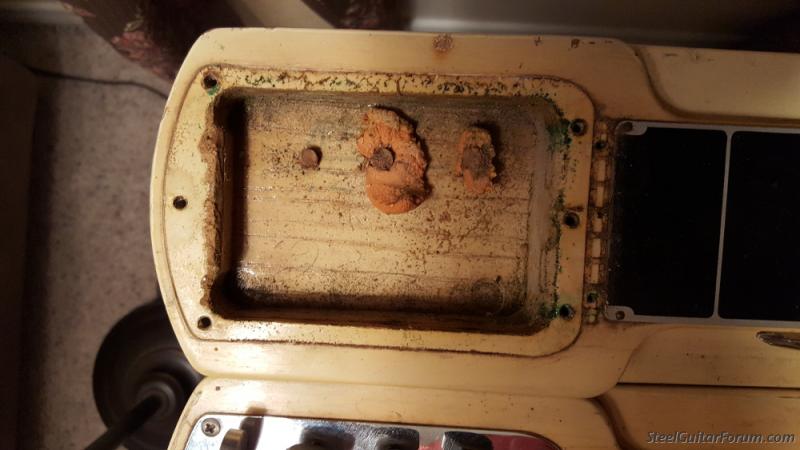
And after I chipped it away:

Most of the donor parts are coming from a near sibling Stringmaster built in 10-54, during the brief time period that the improved old style tuners were available. |
|
|
|
Miles Lang
From:
Venturaloha
|
 Posted 23 Jul 2017 8:55 am
Posted 23 Jul 2017 8:55 am |
|
| Brad Davis wrote: |
| I've installed my 4 best lollipop tuner pans. They shined up nice with Flitz. |
Which Flitz do you use? |
|
|
|
Brad Davis
From:
Texas, USA
|
 Posted 23 Jul 2017 10:51 am
Posted 23 Jul 2017 10:51 am |
|
| Miles Lang wrote: |
| Brad Davis wrote: |
| I've installed my 4 best lollipop tuner pans. They shined up nice with Flitz. |
Which Flitz do you use? |
I don't know if there are different varieties, but I have this old tube I always use on nickel and chrome without issues. Non-abrasive and leaves a protective layer that tends to slow any further tarnishing or corrosion.
 |
|
|
|
Brad Davis
From:
Texas, USA
|
 Posted 23 Jul 2017 11:08 am
Posted 23 Jul 2017 11:08 am |
|
Here it is with all the chrome parts removed, polished and re-installed after cleaning the surface. A few pieces like pickup flanges were replaced. The pickups were surrounded by dirt, and the bridges were particularly nasty. There was a layer of dirt on all the frets. They still have scuffs and nicks, but look pretty decent. I also tightened the body through the front side with a large screwdriver, it didn't take much. Dealt with a few nasty/stripped screws. It's all set to string up and do electronics.
 |
|
|
|
Brad Davis
From:
Texas, USA
|
 Posted 23 Jul 2017 11:55 am
Posted 23 Jul 2017 11:55 am |
|
I also just discovered, in the right light, that there was a name on the front of the guitar, over the 2nd coat of paint I think.
It says "DIANE"

It's to the left of the Fender logo. No indication of another name on the right side. |
|
|
|
Brad Davis
From:
Texas, USA
|
 Posted 25 Jul 2017 4:22 pm
Posted 25 Jul 2017 4:22 pm |
|
I strung up 2 necks and messed with the guitar as is for a day or two. Dull, muffled tone and low volume.
Today I had the parts and rewired the electronics. Amazingly after all the miles on this guitar its wiring circuit is all completely untouched and original as far as I can tell. So it was a shame yet necessary to mess with it.
Here you can see the original circuit. The capacitor is deformed and after 6 decades probably way out of spec. The pots are also suspect.
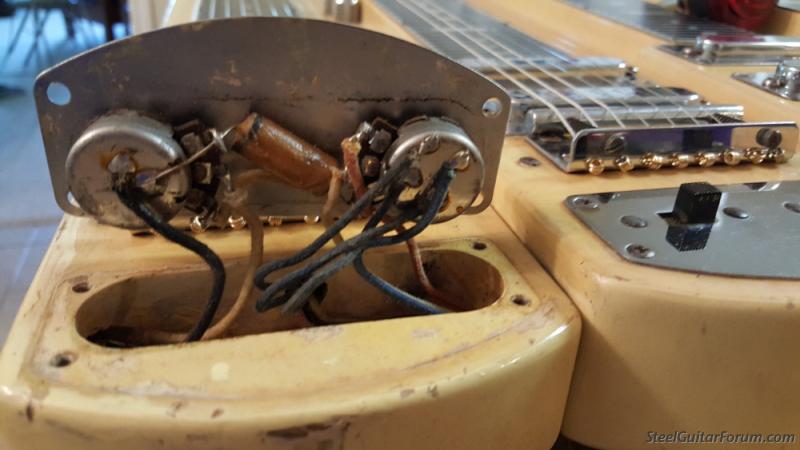
Gloria 12/10/54. She did a pretty good job.
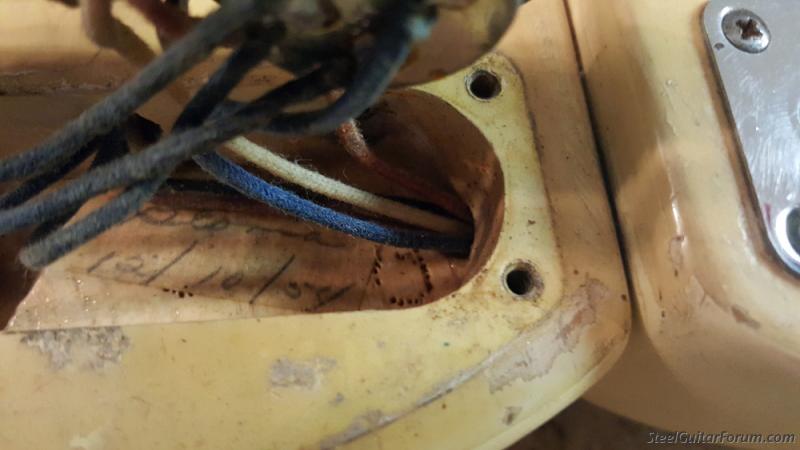
Here I have new stuff wired up and ready to solder the leads, jack and grounds.
I used a CTS 250k audio taper for volume, an Alpha 1Meg linear for the blend, and then the reproduction capacitor I found.
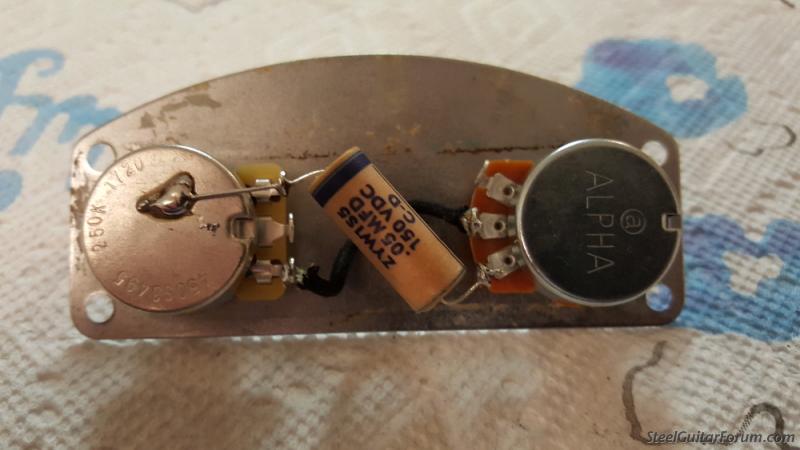
And a short while later, all wired up again:

Unfortunately the 1950s pots seem a tad smaller than modern pots. I couldn't get the control plate screw holes to line up quite right again because of the new pots bumping against the sides of the control cavity. I took a dremel to a couple of the edges and removed an imperceptible amount of wood. I struggled to get everything crammed back in for some reason, with all those wires its tight.
Finally I was able to plug it in. BIG difference in volume and getting a better range of tone. I would not say its done though. I now hear a slight buzz, not much, but I didn't before. So maybe need to go back and check or redo my grounds. But it may just not have been making it through the signal before.
Also thinking the pickup height adjustments need checking. I didn't mess with the switches as they work fine, but worst case I may pull the pickups out and check them over. |
|
|
|
Erv Niehaus
From:
Litchfield, MN, USA
|
 Posted 26 Jul 2017 8:03 am
Posted 26 Jul 2017 8:03 am |
|
Brad,
I've seen the cavities lined with a metal foil to cut down on buzz and hum. |
|
|
|
Brad Davis
From:
Texas, USA
|
 Posted 26 Jul 2017 8:52 am
Posted 26 Jul 2017 8:52 am |
|
Yeah I may go back and add some foil or copper tape, but the buzz is very faint.
What I've found while playing it for a couple of hours is that with the blend pot at 10 all the way I get the thin-sounding bridge pickup only (as expected). All the way at zero I get the dark neck pickup only (expected, I think). Between these two extremes from 1 thru 9, I get a pleasing blended tone, but there is no discernible sweep to my ears. Meaning it is the same blend of tones all the way through the sweep. I'm not certain any defect in my wiring or solder can account for this, and I did re-wire exactly as per the original.
I based my parts selection on a few old early Stringmaster wiring diagrams I found. These listed a 250k audio taper volume, the same .05MFD cap, and a 1Meg linear taper blend pot. But I went back to the old pots and tried to remove some solder from the back so I could read them. The blend pot turns out to be a 25k pot (code reads 304446 - Stackpole pot made 46 week of 54). I have a basket case parts steel here that is 2 months older (10/54), also seems to have original pots. It's blend pot is a 250k, lol. I'm wondering if the important difference is maybe just that these are audio taper. I'm wondering if the 1Meg linear spec in the old diagrams was actually accidentally conflated or carried over from the later Stringmaster designs where it was used for a true tone pot? |
|
|
|
Brad Davis
From:
Texas, USA
|
 Posted 26 Jul 2017 6:41 pm
Posted 26 Jul 2017 6:41 pm |
|
I thought about it some more.
I had used this diagram as a rough guide for the early long scale Stringmaster, posted here and elsewhere. I believe it is accurate and basically matches my quad, but an old post here about it gave the pot values as 250k audio for Volume and 1Meg linear for Blend, although neither is actually specified in the diagram.

Here's another version that does specify the pots

But here is a diagram of the later revised Stringmasters with individual blend controls and true tone knob. I'll take at face value that is basically accurate. The blend pot wiring is necessarily a little different but it accomplishes the same thing.
Here the blend pot is clearly a 250k audio taper. But the tone control, which is missing on the long scales, is in fact a 1Meg linear pot. I think this is where that 1M spec came from, but is not really correct for the long scale blend pot, frequently misidentified as a tone pot.
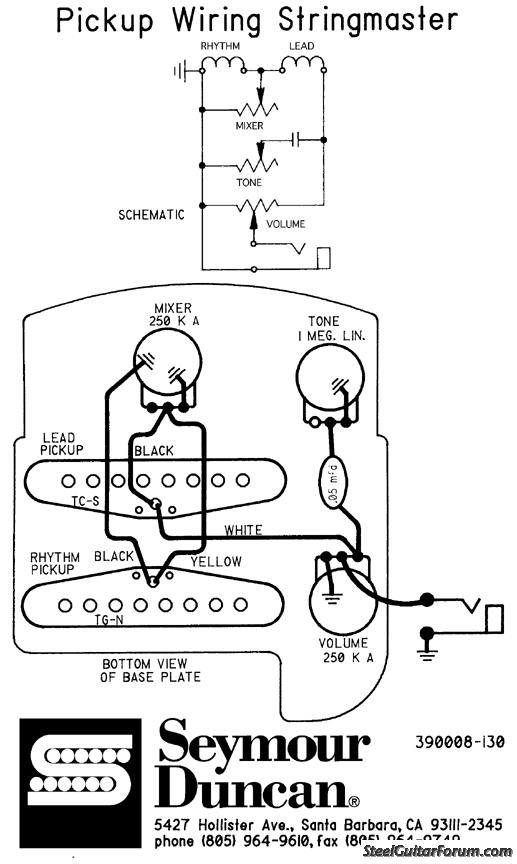
This is where I believe the 1Meg linear component was actually used, but not applicable to the long scale models, as evidenced by 2 different guitars I've examined. I have a few 250k pots in my parts box, but they all have split or knurled shafts. I'm going to order a CTS (or a few) 250k audio with the solid shaft and try it out in a few days. I think audio taper is the important part.
Hopefully that achieves the correct blend function.
I could be wrong, but if so its just a little solder. |
|
|
|
Brad Davis
From:
Texas, USA
|
 Posted 29 Jul 2017 8:32 am
Posted 29 Jul 2017 8:32 am |
|
I got the blend pot swapped out for 250k audio last night, and now I do hear a usable sweep in the blend control, so I'd say for anyone rewiring a long scale in the future just use a pair of 250k audio pots. I considered using 500k blend but not sure it matters.
All the pickups sound really hot. I haven't strung the 4th neck, but maybe I'll do a tuning that I don't really know well for now, like B11, or save it for a Western swing tuning.
A few observations...
I'm new to Stringmasters in general, and long scale especially. After all I've read about how difficult slants are I'm not really having any trouble. Maybe its slants I don't use that are hard, but most of what I do use even way down the neck its really only a minor adjustment. Maybe some 3-fret or split slants might be trickier, although I tried a couple and didn't seem too bad. I don't really have much trouble fretting high on the neck on 22.5 scale, but it is a bit easier on the long scale. Sustain is definitely there.
String breakage.... the only high string right now is the G# on my Helms E6. I used a 10, and it worked fine. I can see where you might have a problem with anything bigger.
String spacing is probably my biggest adjustment so far. Makes me really appreciate how comfortable the spacing is on my Gibson, the Stringmaster is much tighter. I still grip the wrong string occasionally but for the most part I'm getting used to it after spending a few hours on the Fender.
The guitar sounds great, but I'm not sure the amps I have (nothing to write home about) are really voicing it correctly. I've been thinking about a Deluxe Reverb for all my lap steel needs, and this may be my excuse.
This weekend I may start stripping the case down and seeing what I have to work with.
I'm not much of a Hawaiian player, although I do a dab on the Dobro, but I thought this painting I recently did in a group activity was appropriate:
 |
|
|
|
Erv Niehaus
From:
Litchfield, MN, USA
|
 Posted 30 Jul 2017 6:13 am
Posted 30 Jul 2017 6:13 am |
|
Brad,
I know what you mean about string spacing.
My 1st electric guitar was a Gibson lap steel and then I went to a T-8 Fender Stringmaster.
It was hard going from a Gibson to the Fender, but I believe it was harder going back, occasionally, to the Gibson.  |
|
|
|
Brad Davis
From:
Texas, USA
|
 Posted 31 Jul 2017 8:10 pm
Posted 31 Jul 2017 8:10 pm |
|
After a couple of days the Fender string spacing is starting to feel more natural. So yeah, the Gibson might feel strange if I stay away from it for a long time (but who can stay away from a Console Grande?). I'd say the Gibson arrangement is luxurious while the Fender is economical. But wow, the Fender sound!
I'm still playing the guitar dry with only a Goodrich volume pedal. It really sings and sounds amazing, the pickups are super sensitive and can pierce your eardrums and part your hair, lol.
It's a pretty special guitar overall. A rare quad, and in spite of all the miles and scars the guitar and its parts seemed 100% original other than the pitiful attempt at refinishing. My apologies to future generations, but I judiciously swapped out a few parts for identical ones from a sister guitar made a couple months earlier (a lost cause parts guitar), primarily for cosmetic reasons. But I've documented everything I've done. It has a new set of legs, I'm refurbishing the case, and the electronics are all repaired and sounding good. It came covered in grime with cruddy old strings and dead tone and volume. I'll bet this guitar hasn't sounded this good in decades. I kind of took a chance on this guitar and wasn't that sure about it, but fortunately it really hasn't let me down. It just needed a little love. 
BTW these are the replacement legs I bought, and they are excellent:
http://www.ebay.com/itm/Fender-Stringmaster-Replacement-Legs/302273138360 |
|
|
|
Brad Davis
From:
Texas, USA
|
 Posted 29 Aug 2017 2:29 pm
Posted 29 Aug 2017 2:29 pm |
|
I now have a Deluxe Reverb to go with my big Stringmaster quad, and it is sounding amazing. I'm actually really loving the long scale neck. The sustain is wonderful, although I was already accustomed to pretty good sustain on my GCG. And the chimes are so easy and just ring out from this thing. I'm still not having any real difficulty with any kind of slants.
I also have all the materials to re-cover the original tweed case that I started stripping down. The wood needs a little filler here and there but I think it will work fine when I get it all back together.
I've searched for early long-scale wiring diagrams and have found a few. Practically all of them are either slightly inaccurate or incomplete. The scant info I find on long-scale design also seems to frequently conflate or confuse details from the revised Stringmaster models available from 1955 onward. It seems a gentleman by the name of John Tipka once had a web page with a lot of Stringmaster info. The page is long gone for many years now, but thanks to the Internet archive I was able to rediscover it:
http://web.archive.org/web/20060811193343/http://home.insight.rr.com:80/steelgtr/stringmaster.html
Under "Pickups" you can still see the schematics he made available.
Some old posts alluded to one of the long-scale diagrams being based on a Stringmaster diagram from a Fender book by Forrest White. I did get a copy of Forrest White's old Fender book, but it was a few days before I finally discovered the wiring diagram in the back. It turned out to be the most accurate long-scale diagram I have seen -- this is exactly how my 1954 guitar is wired:

Frustratingly, on this diagram a confirmation about the original pot specs remains elusive. As I mentioned before, what few diagrams and old posts I've found indicating pot values say 1Meg linear for the blend pot. My experience with that pot value was not good (no sweep), and I observed both an original 25k and 250k audio pot on the long scale guitars I inspected. I still think the 1Meg linear spec is perhaps mistakenly lifted from the tone pot diagrams for the later Stringmaster design. I switched my blend pot to 250k audio, and it worked well. After a couple weeks I started tinkering again and swapped in a 1Meg audio pot. The difference was minimal.
So without any harder evidence than I have found, I would say for any future readers that the proper original spec pots for an early 1953-1955 long-scale Stringmaster are both 250k audio taper.
Something I'm even less certain of, but my vague impression from my reading is that the earliest Stringmasters in mid-late 1953 were prototypes, and MAY have had a conventional tone pot setup instead of the blend control wiring. I have no evidence if that is really the case though or how exactly it would have been wired, but this "production" wiring is probably more desirable. From early 1954 thru the design switch in early-mid 1955 of course they have this single blend control wiring instead of a tone control.
This is fun, it feels like steel guitar mystery/archaeological quest. |
|
|
|
Brad Davis
From:
Texas, USA
|
 Posted 1 Sep 2017 3:26 pm
Posted 1 Sep 2017 3:26 pm |
|
As far as long scale bridge covers go, I have only procured 2 of them that someone tried to strip down. I don't really know when or if I will find 2 more to have 4 originals, and the 2 I have need re-plating. In the meantime I have used one as a pattern to have 4 of these aluminum copies made. They're not 100% identical to the steel original. The edges and corners on the original are a little rounder and the metal is thinner. But if I can get these chrome plated then pretty much nobody will be any the wiser except the exceedingly rare individual who lays their hand on one of these every day.

 |
|
|
|



